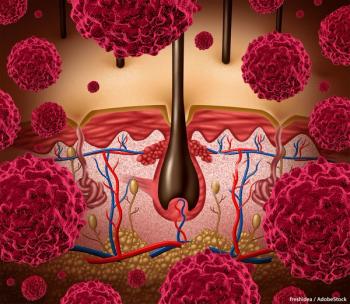
Further Study of Short-Term, High-Dose Interferon Alfa-2b Not Warranted in Melanoma
Results of a phase II study indicate that the use of 1 month of intravenous high-dose interferon alfa-2b alone for the treatment of melanoma was not superior to the standard long-term regimen, and that further study of this approach is not warranted.
Results of a phase II study indicate that the use of 1 month of intravenous high-dose interferon alfa-2b alone for the treatment of melanoma was not superior to the standard long-term regimen. Based on these results, researchers, led by Miranda J. Payne, MD, of Oxford University Hospitals National Health Service Trust, concluded that a phase III study examining the use of short-term, high-dose interferon alfa-2b was not warranted.
The study was
“High-dose interferon is licensed in Europe and the United States for the adjuvant treatment of patients with resected cutaneous melanoma at high risk of disease recurrence, and sufficient positive data exist for many centers to offer treatment to selected patients,” the researchers wrote. “However, marked variation in the dosing and scheduling of interferon alfa-2b in clinical trials, exacerbated by a lack of understanding of its mechanism of action, has hindered assessment of its efficacy, and there is widespread variation in practice.”
In this phase II study, Payne and colleagues randomly assigned patients with stage IIB, IIC, IIIB and IIIC melanoma to receive interferon alfa-2b intravenously daily 5 days a week for 4 weeks (arm A) or the same regimen followed by interferon alfa-2b subcutaneously three times per week for 48 weeks (arm B). The trial included 194 patients enrolled between 2003 and 2009 who were followed for a median of 39.5 months.
Results showed no significant differences in patient outcomes according to the assigned regimen. Relapse-free survival was 22.7 months in patients assigned high-dose intravenous interferon alfa-2b compared with 33.3 months for patients assigned the conventional treatment (P = .28). At 2 years, 50% of patients in arm A were free of relapse compared with 54.1% of patients in arm B.
Although not statistically powered to show a survival difference, results indicated that overall survival favored the long-term interferon alfa-2b arm with the overall survival not yet reached compared with an overall survival of 41.5 months in arm A (P = .05).
In an
New targeted therapies, such as BRAF and MEK inhibitors, that have been found to be effective in the advanced setting are currently undergoing study in the adjuvant setting and results are eagerly awaited, he wrote.
“Although issues of dose and schedule remain complex, the study by Payne et al reminds us that the high-dose regimen remains one option for patients at high risk of developing distant disease,” McArthur wrote.
Newsletter
Stay up to date on recent advances in the multidisciplinary approach to cancer.





















































































